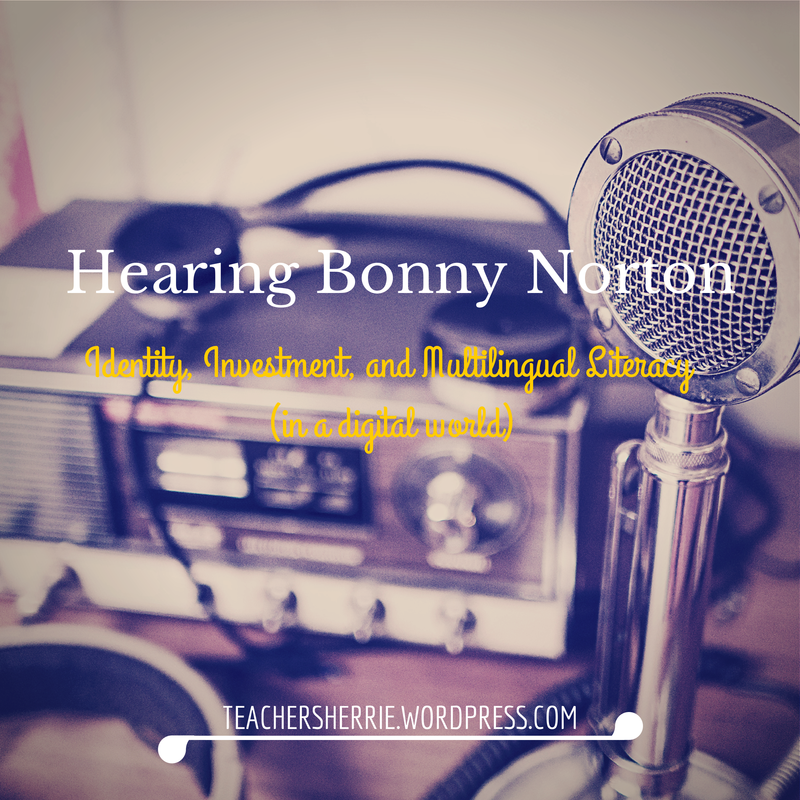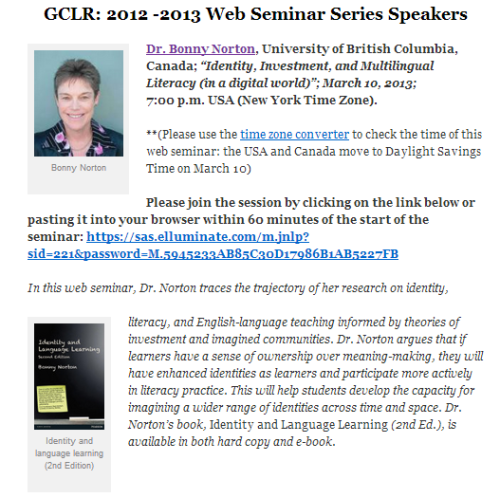Hearing Bonny Norton: Identity, Investment, and Multilingual Literacy (in a digital world)
UPDATED: May 1, 2014
Watch archived video
http://www.youtube.com/watch?v=fapiB6zgZUQ
Identity, Investment, and Multilingual Literacy (in a digital world)
Organised by Global Conversations in Literacy Research (GCLR)
It was a rare opportunity to encounter Dr. Bonny Norton from the comfort and convenience of my study, while I was in Singapore, and she in Vancouver. Thanks to the web seminar organised by Global Conversations in Literacy Research (GCLR), I had the privilege to listen first hand to the pioneer of identity and language learning theory. Dr. Norton has researched and written extensively on how individuals have multiple and changing identities across time and space and how these identities influence their language learning.
I didn’t realize Dr Norton herself was an example of multiple identities. As I was hearing her speak, I couldn’t quite place her accent until she introduced herself as a scholar, a white woman in Canada, with a South African accent. The awareness and acceptance of how we have multiple roles and identities feature prominently in her writing. As she explained in the seminar, having multiple identities empowers learners, instead of restricting them to choosing one identity over the other. For Dr. Norton, that meant that she didn’t have to choose being Canadian over South African.
In the seminar, Dr. Norton focused on her work in Uganda where she and her colleagues introduced digital literacies to teachers and students. The two technological tools they used were the camera and eGranary, literally, the internet in a box filled with millions of digital resources (e.g. wikipedia, educational websites, multimedia documents). With limited infrastructure and access to the Internet and even electricity, students and teachers seized the opportunities to use these newly discovered tools to become better learners, become more respected, and have more power over their learning.
Nonetheless, the limitation of having few cameras and a single computer in a classroom of over a hundred students continue to present obstacles to empowering each and every student. The challenge to overcome poverty and (im)possibilities continues.
Apart from sharing her work in Uganda, Dr. Norton also responded to a few questions from the audience. I asked about how we can create classroom conditions to foster greater investment among students. While much depends on the classroom context including culture and class size, Dr. Norton suggested two strategies:
#1 Students become ethnographers in their communities.
Students write in journals about their experiences in their day-to-day lives in their communities, and share with fellow classmates in the classroom. Through peer sharing, students may find that their experiences are not unique and teachers find out more about their students’ lives. The key is to create a sense of community in the classroom, making the classroom a vibrant place where the teacher helps to develop meaningful relationships among students.
#2 Students speak from positions of strength.
For quiet students who do not participate, teachers can identify their strengths in other areas such as sports or music, and structure classroom activities so their talents come to the fore. By doing so, the student’s identity shifts from being the quiet student to becoming the music virtuoso, for example. Other students begin to relate to that student in a different way and the student is able to speak from a position of strength, rather than weakness.
As Dr. Norton explained at the beginning of the seminar, both the student and community (of teacher and classmates) are responsible for the student’s learning. Thus literacy is a social practice, and the teacher is responsible for creating conditions for positive learner identity and greater investment in learning.
After hearing
After reading numerous research articles by Dr. Norton, as well as others who have based their research on her theories, the personal encounter with Dr. Norton herself (albeit mediated by one-way video conferencing) has helped me connect the dots. The theory comes alive when the author articulates it and I look forward to many more of these web seminars which build bridges across continents and time zones.
Related articles
- One More Look @ Introversion: Digital Literacy and the Quiet Child (solve4why.wordpress.com)
- A Must Have Poster on Digital Literacy (educatorstechnology.com)
- Triumph Learning Partners with Recorded Books to Bring Thousands of Digital Audiobooks to the Classroom (prweb.com)

